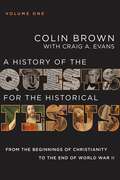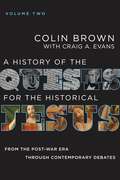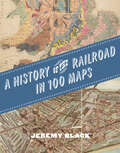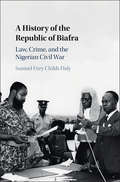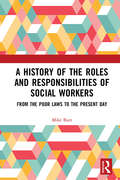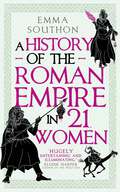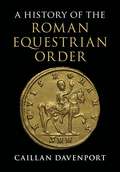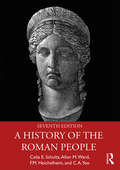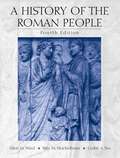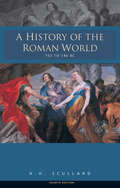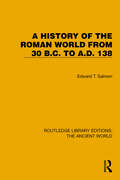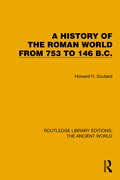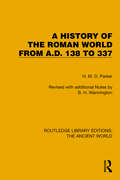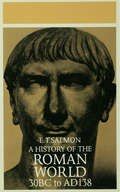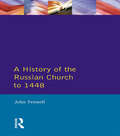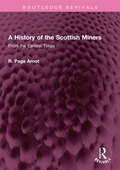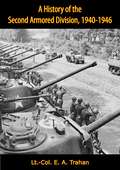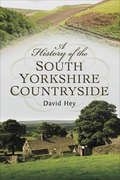- Table View
- List View
A History of the Quests for the Historical Jesus, Volume 1: From the Beginnings of Christianity to the End of World War II
by Colin Brown Craig A. EvansA comprehensive, two-volume reassessment of the quests for the historical Jesus that details their origins and underlying presuppositions as well as their ongoing influence on today's biblical and theological scholarship.Jesus' life and teaching is important to every question we ask about what we believe and why we believe it. And yet there has never been common agreement about his identity, intentions, or teachings—even among first-century historians and scholars. Throughout history, different religious and philosophical traditions have attempted to claim Jesus and paint him in the cultural narratives of their heritage, creating a labyrinth of conflicting ideas.From the evolution of orthodoxy and quests before Albert Schweitzer's famous "Old Quest," to today's ongoing questions about criteria, methods, and sources, A History of the Quests for the Historical Jesus not only chronicles the developments but lays the groundwork for the way forward.The late Colin Brown brings his scholarly prowess in both theology and biblical studies to bear on the subject, assessing not only the historical and exegetical nuts and bolts of the debate about Jesus of Nazareth but also its philosophical, sociological, and theological underpinnings. Instead of seeking a bedrock of "facts," Brown stresses the role of hermeneutics in formulating questions and seeking answers.Colin Brown was almost finished with the manuscript at the time of his passing in 2019. Brought to its final form by Craig A. Evans, this book promises to become the definitive history and assessment of the quests for the historical Jesus.Volume One covers the period from the beginnings of Christianity to the end of World War II.Volume Two (sold separately) covers the period from the post-War era through contemporary debates.
A History of the Quests for the Historical Jesus, Volume 2: From the Post-War Era through Contemporary Debates
by Colin Brown Craig A. EvansA comprehensive, two-volume reassessment of the quests for the historical Jesus that details their origins and underlying presuppositions as well as their ongoing influence on today's biblical and theological scholarship.Jesus' life and teaching is important to every question we ask about what we believe and why we believe it. And yet there has never been common agreement about his identity, intentions, or teachings—even among first-century historians and scholars. Throughout history, different religious and philosophical traditions have attempted to claim Jesus and paint him in the cultural narratives of their heritage, creating a labyrinth of conflicting ideas.From the evolution of orthodoxy and quests before Albert Schweitzer's famous "Old Quest," to today's ongoing questions about criteria, methods, and sources, A History of the Quests for the Historical Jesus not only chronicles the developments but lays the groundwork for the way forward.The late Colin Brown brings his scholarly prowess in both theology and biblical studies to bear on the subject, assessing not only the historical and exegetical nuts and bolts of the debate about Jesus of Nazareth but also its philosophical, sociological, and theological underpinnings. Instead of seeking a bedrock of "facts," Brown stresses the role of hermeneutics in formulating questions and seeking answers.Colin Brown was almost finished with the manuscript at the time of his passing in 2019. Brought to its final form by Craig A. Evans, this book promises to become the definitive history and assessment of the quests for the historical Jesus.Volume One (sold separately) covers the period from the beginnings of Christianity to the end of World War II.Volume Two covers the period from the post-War era through contemporary debates.
A History of the Railroad in 100 Maps
by Jeremy BlackThe first international history of railroads and railroad infrastructure told through stunningly reproduced maps. Since their origins in eighteenth-century England, railroads have spread across the globe, changing everything in their path, from where and how people grew and made things to where and how they lived and moved. Railroads rewrote not only world geography but also the history of maps and mapping. Today, the needs of train companies and their users continue to shape the maps we consume and consult. Featuring full-color maps primarily from the British Library's distinguished collection—many of them never before published—A History of the Railroad in 100 Maps is the first international history of railroads and railroad infrastructure told through maps. Jeremy Black includes examples from six continents, spanning a variety of uses from railroad planning and operations to guides for passengers, shippers, and tourists. Arranged chronologically, the maps are accompanied by explanatory text that sheds light on the political, military, and urban development histories associated with the spread of railroads. A final chapter considers railroad maps from games, books, and other cultural artifacts. For anyone interested in the history of railroads or maps, A History of the Railroad in 100 Maps will offer new and unexpected insights into their intertwined global history.
A History of the Republic of Biafra: Law, Crime, and the Nigerian Civil War
by Samuel Fury DalyThe Republic of Biafra lasted for less than three years, but the war over its secession would contort Nigeria for decades to come. Samuel Fury Childs Daly examines the history of the Nigerian Civil War and its aftermath from an uncommon vantage point – the courtroom. Wartime Biafra was glutted with firearms, wracked by famine, and administered by a government that buckled under the weight of the conflict. In these dangerous conditions, many people survived by engaging in fraud, extortion, and armed violence. When the fighting ended in 1970, these survival tactics endured, even though Biafra itself disappeared from the map. Based on research using an original archive of legal records and oral histories, Daly catalogues how people navigated conditions of extreme hardship on the war front, and shows how the conditions of the Nigerian Civil War paved the way for the country's long experience of crime that was to follow.
A History of the Roles and Responsibilities of Social Workers: From the Poor Laws to the Present Day
by Mike BurtTracing the origin of work with the ‘impotent poor’ under the Poor Laws, to social workers’ current responsibilities towards vulnerable people, this book introduces the reader to the way in which the identification of particular social problems at the end of the nineteenth century led to the emergence of a wide range of separate occupational groups and voluntary workers, which were sometimes, but increasingly, referred to as social workers. Using an extended single chronological historical narrative and analysis, which draws heavily on original archival sources and contemporary literature, it addresses the changes which took place as part of the welfare state and the identification of common roles and responsibilities by social workers, which led to the formation of the British Association of Social Workers in 1970. By highlighting the changes and continuities in these roles and responsibilities, this book will be of interest to all academics, students, and practitioners working within social work, who wish to know more about the origins of their discipline and the current state of the profession today.
A History of the Roman Empire in 21 Women
by Emma SouthonRome as you&’ve never seen it before – brazenly unconventional, badly behaved and ever so feminine. &‘Hugely entertaining and illuminating&’ —Elodie Harper, author of The Wolf Den A WATERSTONES BEST HISTORY BOOK OF 2023 Here&’s how the history of the Roman Empire usually goes… We kick off with Romulus murdering his brother, go on to Brutus overthrowing Tarquin, bounce through an appallingly tedious list of battles and generals and consuls, before emerging into the political stab-fest of the late Republic. After &‘Et tu, Brute?&’, it runs through all the emperors, occasionally nodding to a wife or mother to show how bad things get when women won&’t do as they&’re told, until Constantine invents Christianity only for Attila the Hun to come and ruin everything. Let&’s tear up this script. The history of Rome and its empire is so much more than these &‘Important Things&’. In this alternative history, Emma Southon tells another story about the Romans, one that lives through Vestal Virgins and sex workers, business owners and poets, empresses and saints. Discover how entrepreneurial sex worker Hispala Faecenia uncovered a conspiracy of treason, human sacrifice and Bacchic orgies so wild they would make Donna Tartt blush, becoming one of Rome&’s unlikeliest heroes. Book yourself a table the House of Julia Felix and get to know Pompeii&’s savviest businesswoman and restauranteur. Indulge in an array of locally sourced delicacies as you take in the wonderful view of Mount Vesuvius… what could possibly go wrong? Join the inimitable Septimia Zenobia, who – after watching a series of incompetent, psychopathic and incompetently psychopathic emperors almost destroy the Empire – did what any of us would do. She declared herself Empress, took over half the Roman Empire and ran it herself.
A History of the Roman Equestrian Order
by Dr Caillan DavenportIn the Roman social hierarchy, the equestrian order stood second only to the senatorial aristocracy in status and prestige. Throughout more than a thousand years of Roman history, equestrians played prominent roles in the Roman government, army, and society as cavalrymen, officers, businessmen, tax collectors, jurors, administrators, and writers. This book offers the first comprehensive history of the equestrian order, covering the period from the eighth century BC to the fifth century AD. It examines how Rome's cavalry became the equestrian order during the Republican period, before analysing how imperial rule transformed the role of equestrians in government. Using literary and documentary evidence, the book demonstrates the vital social function which the equestrian order filled in the Roman world, and how this was shaped by the transformation of the Roman state itself.
A History of the Roman People
by Celia E. Schultz Allen M. Ward F. M. Heichelheim C. A. YeoA History of the Roman People offers students a comprehensive, up-to-date, readable introduction to the whole span of Roman history. Richly illustrated, this fully updated volume takes readers through the mists of Roman prehistory and a survey of the peoples of pre-Roman Italy to a balanced, thoughtful account of the complexities of the Roman Republic, its evolution into a full-fledged empire, and its ultimate decline. This latest edition enhances the political narrative with explorations of elements of daily life in the Roman world. New features in this edition include: Addition of boxes that expand on interesting elements of Roman culture mentioned only in passing in the main text. The visual arrangement of the text helps students bear in mind what is supplemental to the central narrative Increased emphasis on the contributions of women to Roman society and in religious matters Incorporation of recent archaeological finds and current debates A History of the Roman People is an excellent introduction for those with no background in Roman history. Its clear, accessible language makes it perfect for undergraduate readers in courses on Roman history and Roman culture. More experienced students wanting to expand their knowledge will also find it a rich resource for the full sweep of Roman antiquity.
A History of the Roman People
by Allen Mason Ward Fritz M. Heichelheim Cedric A. YeoThis 4th edition of the popular text continues to provide a comprehensive analytical survey of Roman history from its prehistoric roots in Italy and the wider Mediterranean world to the dissolution of the Roman Empire in Late Antiquity in A.D. 600.
A History of the Roman World 753-146 BC: 753 To 146 Bc (Routledge Classics Ser.)
by H.H. ScullardThis definitive study from the author of From the Gracchi to Nero, examines the period from the foundation of Rome to the fall of Carthage. An accessible introduction to these centuries of change, this book will also be useful as context for those studying later developments in Roman history.
A History of the Roman World from 146 to 30 B.C. (Routledge Library Editions: The Ancient World)
by Frank Burr MarshA History of the Roman World from 146 to 30 B.C. (1963) analyses the workings of the Roman constitution alongside looking at the events in Roman history from the time of the Gracchi to the death of Antony. It shows that the supremacy of the senate was based on a well-organised political machine, and that the economic, social and political changes which resulted from the conquest of the Mediterranean world weakened the senate’s control without providing a substitute, and so led to the fall of the Republic.
A History of the Roman World from 30 B.C. to A.D. 138 (Routledge Library Editions: The Ancient World)
by Edward T. SalmonA History of the Roman World from 30 B.C. to A.D. 138 (1968) is a comprehensive survey of that period of Roman history during which the Principate was established and the Pax Romana consolidated. Besides the lives of the Emperors and an account of political and military developments, it contains sections on social, economic and cultural life.
A History of the Roman World from 753 to 146 B.C. (Routledge Library Editions: The Ancient World)
by Howard H. ScullardA History of the Roman World from 753 to 146 B.C. (1969) examines the rise of Rome from a small city-state among many to its conquest and unification of Italy and the founding of its overseas Empire. It covers in detail Rome’s struggle with Carthage for supremacy, as well as Rome’s political, economic and social life during the period.
A History of the Roman World from A.D. 138 to 337 (Routledge Library Editions: The Ancient World)
by H.M.D. ParkerA History of the Roman World from A.D. 138 to 337 (1958) looks at the last centuries of the Roman Empire, from the rule of Hadrian and his policy of consolidation of the Roman Empire, halting its further expansion, to the reign of Constantine and the rise of Christianity.
A History of the Roman World: 753 to 146 BC (Routledge Classics)
by H. H. ScullardWith a new foreword by Tim Cornell ‘Can anyone be so indifferent or idle as not to care to know by what means and under what kind of polity almost the whole inhabited world was conquered and bought under the dominion of a single city of Rome?’ – Polybius, Greek Historian The city of Rome created the foundations of an empire that would come to challenge and conquer the great civilizations of Europe and the Near East. H.H. Scullard’s definitive and highly acclaimed study reveals the peculiar genius of the Roman people, their predilection for law and order and their powers of organization and administration, all of which created a confederation the like of which the Greek World had never seen. He explores the political, military, economic and social history of this incredible empire, showing how the Romans realized an ecumenical ideal and embraced Western Civilization within one political system. Celebrated for its political and military victories as well as its incredible feats of engineering, literature and art. Scullard charts the foundation of Rome, the establishment of the Republic, and its spectacular rise until the fall of Carthage. Scullard not only explores the accomplishments of the empire but vividly delves into the corruptive foreign influences which began to undermine the moral qualities of Rome, when lust for power superseded the desire for law and order. A superb overview of this charged historical epoch, A History of the Roman World takes us inside the pivotal events and struggles which have heavily influenced modern western civilizations.
A History of the Roman World: From 30 BC to AD 138
by E. T. SalmonIncluding an account of political and military developments, and including sections on social, economic an cultural life, this book presents a survey of the Roman world at a time when the Principate was established, and the Pax Romana consolidated.
A History of the Rowayton Waterfront: Roton Point, Bell Island and the Norwalk Shoreline
by Karen JewellWelcome to Rowayton, a vibrant community nestled on the shores of Long Island Sound and encompassed by the city of Norwalk, Connecticut. Great steamships once delivered thousands of visitors daily to Roton Point to enjoy one of the premier amusement parks on the eastern seaboard. Roton Point was also home to the nation's oldest continuously operated multi-hull racing club and was the birthplace of the winged sail design for C-class catamarans. In this collection of vignettes, rumrunners, a missing two-hundred-foot steamship, a national scandal and the notorious "Long Island Express" hurricane of 1938 that almost destroyed Roton Point all introduce readers to a grand time in New England history.
A History of the Russian Church to 1488
by John L. FennellThe Russian church is central to an understanding of early Russian and Slav history, but for many years there has been no accessible, up-to-date introduction to the subject in English - until now. The late John Fennell's last book, is a masterly survey of the development, nature and role of the early Church in Russia from Christianization of the country in 988, through Kievan and Tatar poeriods to 1448 when the Russian Church finally became totally independent of its mother-church in Byzantium.
A History of the Rutgers University Glee Club
by David F. ChapmanFounded in 1872, the Glee Club is Rutgers University’s oldest continuously active student organization, as well as one of the first glee clubs in the United States. For the past 150 years, it has represented the university and presented an image of the Rutgers man on a national and international stage. This volume offers a comprehensive history of the Rutgers Glee Club, from its origins adopting traditions from the German Männerchor and British singing clubs to its current manifestation as a world-recognized ensemble. Along the way, we meet the colorful and charismatic men who have directed the group over the years, from the popular composer and minstrel performer Loren Bragdon to the classically-trained conductor Patrick Gardner. And of course, we learn what the club has meant to the generations of talented and dedicated young men who have sung in it. A History of the Rutgers University Glee Club recounts the origins of the group’s most beloved traditions, including the composition of the alma mater’s anthem “On the Banks of the Old Raritan” and the development of the annual Christmas in Carol and Song concerts. Meticulously researched, including a complete discography of the club’s recordings, this book is a must-have for all the Rutgers Glee Club’s many fans and alumni.
A History of the Scottish Miners: From the Earliest Times (Routledge Revivals)
by Robert Page ArnotFirst published in 1955, A History of the Scottish Miners recounts the peculiar circumstances of the seventeenth and eighteenth centuries, and the laws that placed the miners under conditions unique in Europe. Carrying onto the nineteenth century, the author deals with the first trade unions, the period of Alexander McDonald and Keir Hardie, ending in the great strike of 1894 and the formation of the Scottish Miners’ Federation, embracing eight county associations. From 1894 onwards, Robert Smillie led the Scots in good times and bad, up to the ordeal of the First World War. The effect in Scotland of the great lockouts of 1921 and 1926, with Robert Smillie no longer chairman of the British miners but still the leader in Scotland, is set out in detail. Then after a time of troubles, the Scots miners developed their organisations during the war and, before its end, under new leaders, they achieved a single union for Scotland. This book will be of interest to students of history, sociology, economics and political science.
A History of the Second Armored Division, 1940-1946
by Lt.-Col. E. A. TrahanOriginally published in 1946, this book is an official unit history for the 2d Armored Division in World War II, which was activated on 15 July 1940 and participated in campaigns in Normandy, Northern France, Rhineland, Ardennes-Alsace, Central Europe, and Sicily.Elements of the Division first saw action in North Africa, landing at Casablanca in November 1942, and later took part in the fighting at Beja, Tunisia, but as a whole did not enter combat until the invasion of Sicily, when it made an assault landing at Gela in July 1943 and saw action at Butera, Campobello, and Palermo.After the Sicilian campaign, the Division trained in England for the cross-Channel invasion, landed in Normandy D plus 3 on 9 June 1944, and went into action in the vicinity of Carentan. The Division raced across France in July and August, drove through Belgium, and attacked across the Albert Canal in September, crossing the German border at Schimmert to take up defensive positions near Geilenkirchen. In October, it launched an attack on the Siegfried Line from Marienberg, broke through, crossed the Wurm River, and seized Puffendorf and Barmen in November. It was holding positions on the Roer when it was ordered to help contain the German Ardennes offensive.The Division helped reduce the Bulge in January 1945, fighting in the Ardennes forest in deep snow, and cleared the area from Houffalize to the Ourthe River of the enemy. After a rest in February, the Division drove on across the Rhine in March, and was the first American Division to reach the Elbe at Schonebeck in April, where it was halted, on orders. In July 1945, the Division entered Berlin—the first American unit to enter the German capital city.Known as the "Hell on Wheels" division, the 2d Armored Division was one of the most famous American units in World War II.Richly illustrated throughout with photos of the 2d Armored Division, General George Patton, battle photographs and maps.
A History of the Small Arms Made by the Sterling Armament Company: Excellence in Adversity
by James Edmiston Peter Laidler David HowroydAn in-depth history of the small arms made by the Sterling Company of Dagenham, Essex, England, from 1940 until the company closed in 1989.The Lanchester and the Patchett Machine Carbines were both developed at Sterling Engineering Co Ltd during World War II.With the appearance of the earliest Patchett prototypes the military began testing them in ever more rigorous trials, wherein the Patchett kept proving its merits. This led to limited UK adoption of the MkII Patchett as the L2A1 in 1953, and the “first Sterling,” the MkII, as the L2A2 in 1955.Then came Sterling’s “Crown Jewel,” the superb Mk4, adopted as the general-issue UK “Gun, Sub-Machine, L2A3” in September, 1955. Manufactured briefly but intensively by ROF Fazakerley (1955–1959) and by Sterling for over 30 years, nearly 4,000,000 were made.Unlike wraparound bolt designs like the UZI, the Sterling was capable of being truly silenced with standard 9mm ball ammunition (as opposed to being merely “suppressed”). The excellent silenced Sterling-Patchett Mk5, adopted as the UK L34A1 in 1967, is the only Sterling remaining in British Service.All prototypes, military Marks, commercial and licensed production models of the Sterling are described, including the Canadian C1 SMG and the Indian 1A Carbine. Contains notes on manufacturing methods and procedures as used at Sterling, ROF Fazakerley, Canadian Arsenals Limited and the Indian Small Arms Factory, Kanpur (Cawnpore), plus extensive notes on inter-model interchangeability, serial number ranges, quantities produced, client-country purchases of the various Sterling Marks, and accessories.Praise for A History of the Small Arms made by the Sterling Armament Company“If you have an interest in small arms then this is a book that belongs in your library or book shelf. The book does a great job of providing the reader with the story of the weapons that evolved into the Sterling sub-machine gun and the changes in design that took place over that history. The result was a weapon that served in many fields of conflict and performed admirably.” —Armorama
A History of the South Yorkshire Countryside
by David HeySouth Yorkshire has some of the most varied countryside in England, ranging from the Pennine moors and the wooded hills and valleys in the west to the estate villages on the magnesian limestone escarpment and the lowlands in the east. Each of these different landscapes has been shaped by human activities over the centuries. This book tells the story of how the present landscape was created. It looks at buildings, fields, woods and moorland, navigable rivers and industrial remains, and the intriguing place-names that are associated with them.
A History of the Soviet Union from the Beginning to Its Legacy
by Peter KenezThis concise yet comprehensive textbook examines political, social, and cultural developments in the Soviet Union and the post-Soviet period. It begins by identifying the social tensions and political inconsistencies that spurred radical change in Russia's government, from the turn of the century to the revolution of 1917. Peter Kenez presents this revolution as a crisis of authority that the creation of the Soviet Union resolved. The text traces the progress of the Soviet Union through the 1920s, the years of the New Economic Policies, and into the Stalinist order. It illustrates how post-Stalin Soviet leaders struggled to find ways to rule the country without using Stalin's methods - but also without openly repudiating the past - and to negotiate a peaceful but antipathetic coexistence with the capitalist West. This updated third edition includes substantial new material, discussing the challenges Russia currently faces in the era of Putin.
A History of the Soviet Union from the Beginning to the End
by Peter KenezPeter Kenez's History of the Soviet Union examines not only political change, but also social and cultural developments. The book identifies the social tensions and political inconsistencies that spurred radical change in the government of Russia, beginning at the turn of the century, culminating in the revolution of 1917. Kenez envisions that revolution as a crisis of authority that posed the question, 'Who shall govern Russia'? This question was resolved with the creation of the Soviet Union. Kenez traces the development of the Soviet Union from the Revolution, through the 1920s, the years of the New Economic Policies - which he sees as crucial to any interpretation of the history of the Soviet Union - and into the Stalinist order. He shows how post-Stalin Soviet leaders struggled to find ways to rule the country without using Stalin's methods but also without openly repudiating the past, and to negotiate a peaceful but antipathetic coexistence with the capitalist West.
